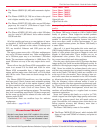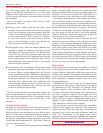
The Color Laser Printer Guide: Industry Briefing
Entire Contents © 2006 Progressive Business Publications. Copying of Pages Prohibited.To Order: 800 247 2185 or www.betterbuys.com 61
Color Fundamentals
Let’s focus next on some of the main technical and per-
formance issues that crop up in any discussion of color
printers.
Laser basics
As with monochrome machines, color laser printers work
by having a light source etch an image onto a photosen-
sitive drum that then attracts toner; the toner is trans-
ferred to paper, heated, and fused; and an image is creat-
ed. The difference is that with monochrome lasers, the
process is completed with one pass through the machine,
but with older color models, the imaging (at least tradi-
tionally) takes place a total of four times — one for each
of the four process colors from which all composite col-
ors are formed. This explains why color print speeds have
typically been much slower.
But lately, the fastest models are using tandem engines
featuring a one-pass process, resulting in color speeds
that are the same or almost as fast as black-only ones.
The engine prints the three basic printer colors — cyan,
magenta, and yellow — in tandem with black, in a single
pass of
the paper thr
ough the ima
ging unit. These one-
pass engines ma
y be either laser- or LED-po
wered. In the
past few years, this technology has almost completely
taken o
ver the industry. Only older and less expensive
models offer four-pass color
.
Solid ink jet:
laser-class alternative
Solid ink jet tec
hnology shouldn’t be confused with ther
-
mal ink jet, the much more common and less expensive
variety. The image quality, full-color speed, and price of
solid ink jet all place it in the laser class.
At present, Xerox is the only vendor in this guide that
of
f
ers products using solid ink jet technology. (As we
mentioned above, Xerox also sells color laser and LED
printer
s
.)
Solid ink jet technology relies on a solid block of ink
that’s melted and dropped precisely onto the paper. The
ink r
esolidifies immedia
tely in a process designed to
maintain its clarity. Because very little ink soaks into the
paper, solid ink jets deliver brighter colors than regular
laser
.
Speeds ar
e brisk b
y full-color standar
ds
.
Solid ink jets aren’t fussy about what type of plain paper
they print onto — they generally work fine with regular
copier and laser printer paper. One benefit of the technol-
ogy is that the output doesn’t smudge if it gets wet.
R
ecent de
v
elopments b
y Xer
o
x ha
ve diminished some
ear
lier disad
v
anta
g
es of solid ink jet printing, such as a
tendency to jam in copier document feeders due to added
t
hickness and its vulnerability to scratches.
Xerox’s solid ink jet machines are comparable to the
less expensive color lasers. Therefore, the product posi-
tioning stresses brilliant colors, along with economy, as a
reason to opt for this technology. Xerox has established a
successful niche with these printers.
You may sometimes hear solid ink jets referred to as
“phase change” printers, a term that refers to the melt-
ing/resolidifying process — there’s no special signifi-
cance to this, and the term is synonymous with “solid ink
jet.”
The colors themselves
All color print technologies involve mixing three or four
basic colors to create millions of color combinations. You
may hear of a three-color palette abbreviated “CMY,”
standing for cyan, magenta, and yellow. To form a com-
posite black, CMY printers combine the three primary
colors.
However, current color laser printers — including all
featured in this guide — have a separate, true black (des-
ignated as “K” in printer lingo). This four-color palette is
referred to as “CMYK,” and it’s preferable to the three-
color variety: CMYK models typically generate richer-
looking black te
xt than those that combine the CMY col-
ors to create composite black. The colors themselves
come in the form of different substances, depending on
the print technolo
gy — in the case of laser
s, it is toner.
Keep in mind that computer monitors use a different
palette — red, green, and blue (RGB) — to mix their col-
or
s. To reconcile the two color sets, some printers include
color
-matching software that lets users specify which
monitor they have, enabling the printer to adjust the out-
put to ma
tc
h the monitor.
In addition, there is a whole subindustry devoted to
third-party software and hardware tools designed to con-
trol, match, and calibrate color to satisfy the pickiest peo-
ple. Advanced users (especially those in the graphic arts,
publishing, and design businesses) will look for “manual”
contr
ols
. However, most mainstream users will be con-
tent with softw
are that automatically optimizes color
r
e
pr
oduction to suit the content of
eac
h pa
g
e
.
How important is resolution?
T
he best w
ay to judge print quality is simply to look at it.
If
you must judge image quality by reviewing machine
specifications, you should be aware that there are differ-
ing schools of thought as to what matters most. In the
black-and-white market, the main reference point on a
spec sheet when it comes to image quality is a printer’s
r
esolution. This is measured by the number of dots per
square inch, normally noted as the number of dots per
inc
h in a r
o
w times the n
umber of
dots in a column.
F
or


















